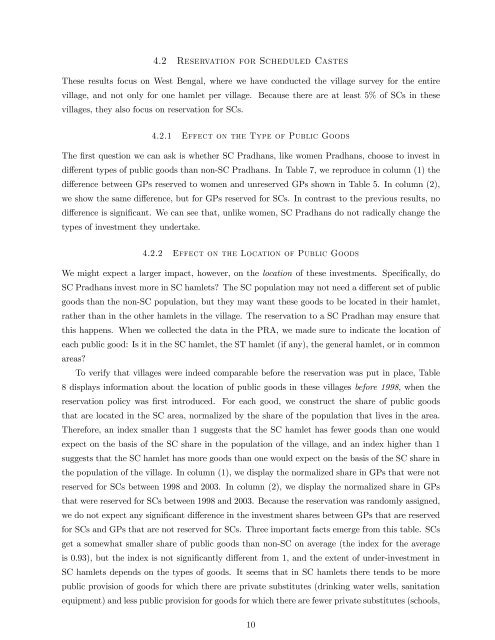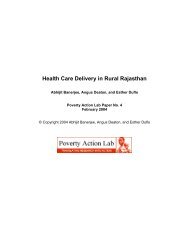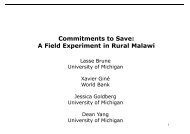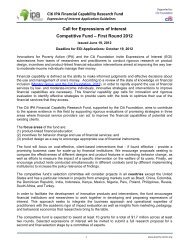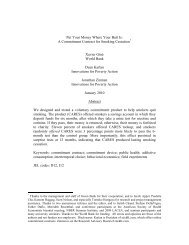The Impact of Reservation in the Panchayati Raj - Innovations for ...
The Impact of Reservation in the Panchayati Raj - Innovations for ...
The Impact of Reservation in the Panchayati Raj - Innovations for ...
You also want an ePaper? Increase the reach of your titles
YUMPU automatically turns print PDFs into web optimized ePapers that Google loves.
4.2 <strong>Reservation</strong> <strong>for</strong> Scheduled Castes<strong>The</strong>se results focus on West Bengal, where we have conducted <strong>the</strong> village survey <strong>for</strong> <strong>the</strong> entirevillage, and not only <strong>for</strong> one hamlet per village. Because <strong>the</strong>re are at least 5% <strong>of</strong> SCs <strong>in</strong> <strong>the</strong>sevillages, <strong>the</strong>y also focus on reservation <strong>for</strong> SCs.4.2.1 Effect on <strong>the</strong> Type <strong>of</strong> Public Goods<strong>The</strong> first question we can ask is whe<strong>the</strong>r SC Pradhans, like women Pradhans, choose to <strong>in</strong>vest <strong>in</strong>different types <strong>of</strong> public goods than non-SC Pradhans. In Table 7, we reproduce <strong>in</strong> column (1) <strong>the</strong>difference between GPs reserved to women and unreserved GPs shown <strong>in</strong> Table 5. In column (2),we show <strong>the</strong> same difference, but <strong>for</strong> GPs reserved <strong>for</strong> SCs. In contrast to <strong>the</strong> previous results, nodifference is significant. We can see that, unlike women, SC Pradhans do not radically change <strong>the</strong>types <strong>of</strong> <strong>in</strong>vestment <strong>the</strong>y undertake.4.2.2 Effect on <strong>the</strong> Location <strong>of</strong> Public GoodsWe might expect a larger impact, however, on <strong>the</strong> location <strong>of</strong> <strong>the</strong>se <strong>in</strong>vestments. Specifically, doSC Pradhans <strong>in</strong>vest more <strong>in</strong> SC hamlets? <strong>The</strong> SC population may not need a different set <strong>of</strong> publicgoods than <strong>the</strong> non-SC population, but <strong>the</strong>y may want <strong>the</strong>se goods to be located <strong>in</strong> <strong>the</strong>ir hamlet,ra<strong>the</strong>r than <strong>in</strong> <strong>the</strong> o<strong>the</strong>r hamlets <strong>in</strong> <strong>the</strong> village. <strong>The</strong> reservation to a SC Pradhan may ensure thatthis happens. When we collected <strong>the</strong> data <strong>in</strong> <strong>the</strong> PRA, we made sure to <strong>in</strong>dicate <strong>the</strong> location <strong>of</strong>each public good: Is it <strong>in</strong> <strong>the</strong> SC hamlet, <strong>the</strong> ST hamlet (if any), <strong>the</strong> general hamlet, or <strong>in</strong> commonareas?To verify that villages were <strong>in</strong>deed comparable be<strong>for</strong>e <strong>the</strong> reservation was put <strong>in</strong> place, Table8 displays <strong>in</strong><strong>for</strong>mation about <strong>the</strong> location <strong>of</strong> public goods <strong>in</strong> <strong>the</strong>se villages be<strong>for</strong>e 1998, when <strong>the</strong>reservation policy was first <strong>in</strong>troduced. For each good, we construct <strong>the</strong> share <strong>of</strong> public goodsthat are located <strong>in</strong> <strong>the</strong> SC area, normalized by <strong>the</strong> share <strong>of</strong> <strong>the</strong> population that lives <strong>in</strong> <strong>the</strong> area.<strong>The</strong>re<strong>for</strong>e, an <strong>in</strong>dex smaller than 1 suggests that <strong>the</strong> SC hamlet has fewer goods than one wouldexpect on <strong>the</strong> basis <strong>of</strong> <strong>the</strong> SC share <strong>in</strong> <strong>the</strong> population <strong>of</strong> <strong>the</strong> village, and an <strong>in</strong>dex higher than 1suggests that <strong>the</strong> SC hamlet has more goods than one would expect on <strong>the</strong> basis <strong>of</strong> <strong>the</strong> SC share <strong>in</strong><strong>the</strong> population <strong>of</strong> <strong>the</strong> village. In column (1), we display <strong>the</strong> normalized share <strong>in</strong> GPs that were notreserved <strong>for</strong> SCs between 1998 and 2003. In column (2), we display <strong>the</strong> normalized share <strong>in</strong> GPsthat were reserved <strong>for</strong> SCs between 1998 and 2003. Because <strong>the</strong> reservation was randomly assigned,we do not expect any significant difference <strong>in</strong> <strong>the</strong> <strong>in</strong>vestment shares between GPs that are reserved<strong>for</strong> SCs and GPs that are not reserved <strong>for</strong> SCs. Three important facts emerge from this table. SCsget a somewhat smaller share <strong>of</strong> public goods than non-SC on average (<strong>the</strong> <strong>in</strong>dex <strong>for</strong> <strong>the</strong> averageis 0.93), but <strong>the</strong> <strong>in</strong>dex is not significantly different from 1, and <strong>the</strong> extent <strong>of</strong> under-<strong>in</strong>vestment <strong>in</strong>SC hamlets depends on <strong>the</strong> types <strong>of</strong> goods. It seems that <strong>in</strong> SC hamlets <strong>the</strong>re tends to be morepublic provision <strong>of</strong> goods <strong>for</strong> which <strong>the</strong>re are private substitutes (dr<strong>in</strong>k<strong>in</strong>g water wells, sanitationequipment) and less public provision <strong>for</strong> goods <strong>for</strong> which <strong>the</strong>re are fewer private substitutes (schools,10


